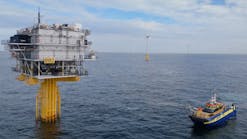Editor's note: This Renewable Energy column first appeared in the November-December 2023 issue of Offshore magazine. Click here to view the full issue.
By Bruce Beaubouef, Houston
Subsea or tidal power turbines may be the next big technology in offshore renewable energy, and research and development efforts are underway on several fronts.
Subsea turbines are a fairly straightforward concept: they are essentially windmills installed onto an ocean floor or river bed. The underwater current produced by the tides spins blades arranged like an airplane propeller. These turbines are attached to a gear box, which is connected to an electrical generator. This produces the electricity that is carried by cable to shore.
But in contrast to windmills, subsea turbines have the advantage of underwater energy capture coming from water’s high density. Water is denser than air, which means that the same amount of energy can be produced by an underwater turbine as a windmill, but at slower speeds and over less area. Moreover, while the amount of wind can be unpredictable, the kinetic energy of tidal areas is dependable. The ebb and flow is so predictable, a given tidal region can be expressed in the amount of kilowatt hours of electricity it can produce per turbine.
The design and deployment of most underwater turbines are still in their infancy, and there is much to learn about how they interact with the underwater environment. The US Department of Energy’s Advanced Research Projects Agency-Energy (ARPA-E) is funding 11 projects with a $38 million bundle of grants made in November 2020 to develop cost-effective underwater turbine technologies. These projects are collectively called Submarine Hydrokinetic And Riverine Kilo-megawatt Systems – SHARKS, for short.
The SHARKS projects aim to develop marine technologies that can generate electricity at an end cost below $0.05 per kilowatt-hour. By one estimate, that is about one-sixth of the current cost of electricity from underwater turbines. One example of an underwater turbine technology being developed under the SHARKS project is the Tidal Power Tug.
Invented by California-based energy developer Aquantis, the Tidal Power Tug turbine is a second-generation floating tidal energy converter. The turbine is equipped with a versatile spar-buoy platform that supports a 10-meter diameter, two-bladed variable-pitch rotor and a 160-kW drivetrain. Moreover, with a parallel-flow rotor, a vertical yawing spar buoy, and analytical tools, the turbine is designed to achieve stable power generation in all sea conditions.
This underwater turbine is said to be ideal for gulf stream currents along the US East Coast, which create multiple circular flows called gyres. The proximity of these energy-intensive gyres to major cities makes them a strategic energy resource.
The National Renewable Energy Laboratory (NREL) is working closely with several SHARK projects. To improve and analyze the efficiencies of these projects, NREL engineers are designing an open-source software that will combine technology design, control, and optimization of the new marine technologies.
In South America, Brazilian startup TidalWatt says that it is developing a new generation of underwater turbines designed specifically to capture energy in the ocean.
The company says that a three-meter diameter TidalWatt turbine is capable of producing 5 MW of power at a current of 1.87 knots — practically the same power as a 180-meter diameter wind turbine, company officials say.
TidalWatt say that it plans to install its turbines in locations with average current speeds above 1 knot, generating 5 MW with the turbine capacity ranging between 70 and 95%.
Elsewhere, CGG has partnered with the Selkie project, a €5.2-million cross-border initiative aiming to boost the marine energy industry in Wales and Ireland. The goal of the Selkie project is to improve the performance of wave and tidal marine energy technologies. CGG says it will work with Selkie project partners to test and validate new technology tools on wave and tidal demonstration projects.
The Selkie project is establishing a network of developers and supply chain companies in Ireland and Wales to create a set of multi-use marine energy technology, engineering and operation tools, templates, standards and models for use across this sector. CGG says that it will draw upon its earth and environmental science capabilities to support the project through the design and testing of new environmental monitoring technology.






